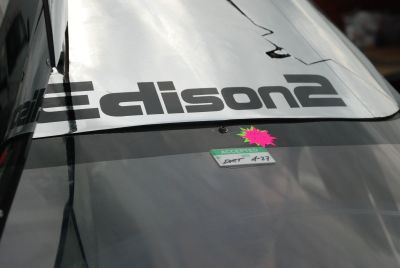Annoy As Little Air As Possible
To say that the Very Light Car displays great aerodynamic efficiency is an understatement. This summer we spent a shift in the GM wind tunnel in Warren, Michigan, and we just flat-out nailed it. We recorded a 0.16 coefficient of drag: the best results ever seen in their wind tunnel, we were told.
No wonder. Our Chief of Aerodynamics is Barnaby Wainfan, the aerodynamics fellow at Northrup Grumman. The goal of aerodynamic efficiency is to punch as small a hole in the air as possible and try to close it seamlessly behind you, or as Barnaby says “annoy as little air as possible.”
Air separates as it flows around a car and inevitably creates a “dead zone” of low pressure behind, an inefficiency known as “base drag”. A way to help close the air is with a tail: either a horizontal “beaver tail”, seen on our X Prize competitor Aptera, or with the vertical “fish tail” we employ.
A big part of not annoying air is keeping it from entering the car except as necessary, such as for cooling. Contemporary cars often have oversize grills and usually exposed wheel wells: both allow air to enter and bang around inside the car. The car grabs this air and accelerates it to the speed the car is traveling and the energy for this comes from the engine.
With the Very Light Car we enclose the wheels outside the body in pods. This design allows a smaller frontal area, with each wheel pod also poking its own small hole in the air. We are deliberate about exactly where and how much air enters the car. We then put the air back outside where it will do the most good, reintroducing it into the “dead zone”. We also avoid exposing anything to the air that we do not have to, using cameras instead of mirrors and flush-mounting the door latches.
Drag coefficient (Cd) might be the headline number but to know actual drag you need to factor in this frontal area. When Cd and frontal area are multiplied together, the product, CdA, allows you to directly compare different cars. It turns out a Hummer H2 (which not only is huge but also has a terrible aerodynamic shape) has about 9 times the drag of the Very Light Car. Even a 2010 Prius, a car with a very good Cd (.25), has almost twice our drag.
At Edison2 we take great care and pride in making only definite and supportable claims about our car. Our drag numbers were obtained by the dedicated and competent engineers running one of the world’s top wind tunnels. We have since backed those numbers up with the best-ever coast down results measured by an equally impressive and credentialed facility.
The overall goal in aerodynamic efficiency is a car that moves through the air with minimal effort. The ultimate would be if the only drag was the friction of air against the car’s body. That perfection may be unattainable, but the Very Light Car comes close.


 Friday, August 20, 2010 at 06:00PM
Friday, August 20, 2010 at 06:00PM
